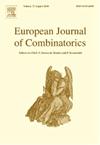Injective edge colorings of degenerate graphs and the oriented chromatic number
IF 0.9
3区 数学
Q1 MATHEMATICS
引用次数: 0
Abstract
Given a graph , an injective edge-coloring of is a function such that if , then no third edge joins an endpoint of and an endpoint of . The injective chromatic index of a graph , written , is the minimum number of colors needed for an injective edge coloring of . In this paper, we investigate the injective chromatic index of certain classes of degenerate graphs. First, we show that if is a -degenerate graph of maximum degree , then . Next, we show that if is a graph of Euler genus , then , which is tight when is a clique. Finally, we show that the oriented chromatic number of a graph is at most exponential in its injective chromatic index. Using this fact, we prove that the oriented chromatic number of a graph embedded on a surface of Euler genus has oriented chromatic number at most , improving the previously known upper bound of and resolving a conjecture of Aravind and Subramanian.
退化图的内射边着色与取向色数
给定一个图G, G的内射边着色是一个函数ψ:E(G)→N,使得如果ψ(E)=ψ(E ‘),则没有第三条边连接E的端点和E ’的端点。图G的内射色指数,记作χinj′(G),是图G的内射边染色所需的最小色数。本文研究了若干类退化图的内射色指数。首先,我们证明了如果G是一个最大度的d-退化图Δ,那么χinj ' (G)=O(d3logΔ)。其次,我们证明了如果G是欧拉格G的图,则χinj ' (G)≤(3+o(1)) G,当G是团时,这是紧的。最后,我们证明了图的有向色数在其内射色指数上最多是指数的。利用这一事实,我们证明了嵌入在欧拉属g表面上的图的有向色数最多为O(g6400),改进了已知的2O(g12+ α)的上界,并解决了Aravind和Subramanian的一个猜想。
本文章由计算机程序翻译,如有差异,请以英文原文为准。
求助全文
约1分钟内获得全文
求助全文
来源期刊
CiteScore
2.10
自引率
10.00%
发文量
124
审稿时长
4-8 weeks
期刊介绍:
The European Journal of Combinatorics is a high standard, international, bimonthly journal of pure mathematics, specializing in theories arising from combinatorial problems. The journal is primarily open to papers dealing with mathematical structures within combinatorics and/or establishing direct links between combinatorics and other branches of mathematics and the theories of computing. The journal includes full-length research papers on important topics.

 求助内容:
求助内容: 应助结果提醒方式:
应助结果提醒方式:


